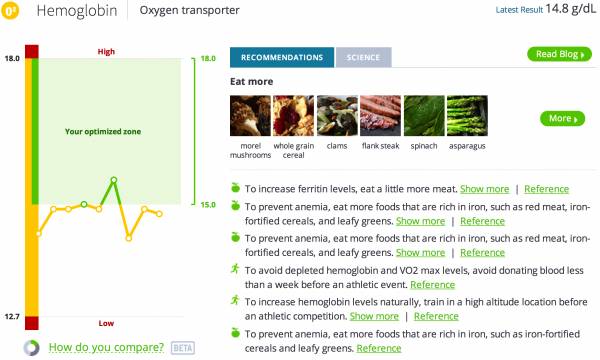In a recent article in FastCompany, Brian Kamenetzky shared how professional teams are looking to reduce injuries by predicting them. An approach that I strongly agree with.
To predict injuries, you need data. Blood analysis is a simple and powerful way to get data critical to anyone interested in improving athletic and personal performance. With blood testing, you open a window inside your body to see your actual biochemical status.
The Benefits of Blood Analysis
For years, however, only professional athletes could afford to use blood testing to improve performance. Most people associated blood testing with trips to the doctor; it was just a way to confirm a disease or medical problem. But now athletes, trainers, coaches, and anyone interested in achieving optimal performance, can use blood testing to predict a problem before it is too late to fix it, sometimes even before it happens.
Athletes looking for the competitive edge have been using blood analysis for years. Recently, triathlete Diane Stokes was feeling sluggish, tired and rundown, so she signed up for a blood test.2 Her results indicated that she was low in magnesium, zinc, vitamin D and testosterone. Changes to her diet and supplement plan recharged her energy levels and performance. Without the blood test, she might have pushed harder on her workouts, making the problem worse. Instead, blood testing gave her the answers she needed to solve the problem.
A blood test requires just a tiny amount of blood to provide a massive amount of information, including how you can optimize your body using simple training, nutrition, and even lifestyle changes. Everyone’s blood contains biomarkers, substances that science has shown can act as indicators to reveal your body’s status. Each biomarker represents a function or biological change going on inside the body, and each biomarker is measurable.
By measuring biomarkers in the blood, scientists can see inside your body accurately and objectively. The more details you know about your biomarker results, the more useful the data is.
Personalization of Blood Analysis
The standard blood tests that your doctor orders will focus on whether or not you are sick. Some biomarker data, however, can reveal the overall state of your wellness and your athletic fitness. In addition, blood analysis should tell you exactly what your results are – and how they compare to other people similar to you.
It’s good to be inside the normal range on your blood test. But when “normal” is the same for a 24-year-old athlete and for a seventy-year-old retiree, it doesn’t tell you very much. Your blood analysis should include a personalized optimal zone based on your age, gender, activity level, and even your sport.

What Biomarkers to Test
Screening your blood can rule out many potential problems that could happen down the road. Early blood testing enables you to deal with the problem or at-risk areas when they are small – before you dig yourself into a hole.
Nearly every team in professional sports does a preseason blood test, but ironically it’s usually for disease and not for performance. Each blood test is usually a collection of biomarkers called a panel, which can range from just a few biomarkers to more than twenty. But all biomarkers should indicate something that people can adjust by modifying what they eat and how they train.
The most useful blood tests include biomarkers for nutrition status, hormones, and inflammation. Vitamins and minerals are the simplest and most straightforward tests, usually showing a deficiency or excess, which can happen when you are taking too many supplements. More complicated biomarkers are hormones, which need sophisticated interpretation based on age, training program, and, of course, gender. Once a problem is detected in a blood test, an intervention or strategy can be applied to improve or restore that biomarker.
Iron Group Example
Blood analysis can be complicated since many biomarkers interact with each other. When one biomarker is out of range, it can trigger a domino effect that pushes other biomarkers out of range. A small nutritional deficiency can snowball.
One example that illustrates how biomarkers interact is your body’s need for iron. Iron is the key component of hemoglobin, the iron-containing oxygen-transporter in red blood cells. Hemoglobin’s primary function is to carry oxygen from the lungs to the muscles, brain, and digestive system where it releases the oxygen for cell use.

Optimal levels of hemoglobin improve strength, increase endurance, and enhance overall aerobic performance. The amount of hemoglobin in your blood depends partly on the amount of iron stored by another biomarker, ferritin. If ferritin is low, you have less hemoglobin and fewer red blood cells to carry oxygen. When your iron is low, you feel fatigued, workouts that were good standbys become demanding, and performance falters.
Which Biomarkers Are Important?
Many people know about common biomarkers such as LDL, HDL, and triglycerides. Every biomarker is unique, but many common biomarkers fall into familiar categories, such as electrolytes, metabolism, and vitamins and minerals.
Less well-known biomarkers such as sex hormone binding globulin, also known as SHBG, are also important. Biomarkers like these help us see the impact of other hormones such as testosterone, a powerful biomarker vital to anyone involved with power sports or weight training, including women.
The Value of Retesting and Unique Benchmarks
Earlier I mentioned optimal ranges for biomarkers. Typically, when you get blood test results from your doctor, you simply find out whether your results are normal. The normal range for a blood test is usually created to identify disease or illness and spans a wide zone. But each individual has his or her own ideal range unique to his or her ethnicity, gender, age, and activity level.
No one would expect a sedentary man to have the same level of testosterone as a professional athlete, yet they both share the same normal range. Therefore, it’s important for any blood analysis to provide benchmarks that compare your results to the range that is ideal for you.

Thus, retesting is the final component of using blood analysis for athletes and fitness enthusiasts, and I recommend at least three tests a year. Why? You need a minimum of three data points to see a trend, and retesting confirms that the attempted change was effective or adhered to. Another important factor is that biomarkers are dynamic, meaning they are susceptible to change for various reasons. Testing one time with an extensive panel is not as smart as testing the most useful biomarkers repeatedly throughout the year.
Making a change may be easy for some people, but like anything, you have to experience it first hand and measure the changes. No matter what panel or blood test you choose, retesting three to four times will show you the big picture of what is going on inside your body.
The Take-Home on Blood Analysis
The use of blood testing, analysis, and interventions for improvement is not as hard as it may seem. Our internal chemistry leaves clues in our blood that are quick and convenient to measure, and those results have both immediate and long-term impact on our health and performance.
Scientific research studies are revealing how diet, training, and sleep can impact our bodies. By screening and doing analysis of our blood, we can find what we need to improve with simple changes. Blood testing should not be seen as a negative process, but as an opportunity to look under the hood of the human vehicle and do the necessary maintenance for ultimate performance.
References:
1. Brian Kamenetzky, “The Next Big Thing in Sports Data: Predicting (and Avoiding Injuries,” FastCompany, August 25, 2014.
2. Perrin Braun, “Diane Stokes Goes the Distance: Fighting Fatigue With InsideTracker,” InsideTracker.com, August 27, 2014.
Photos courtesy of Shutterstock.






